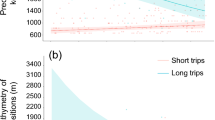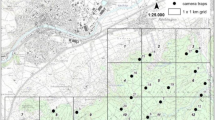Abstract
Predation risk is among the most fundamental selection pressures, making anti-predation behavior a highly adaptive trait. Vigilance and escape are two important aspects of anti-predation behavior and have received considerable attention for decades. However, the relationship between them remains largely unexplored, and our knowledge on the diel patterns of these behaviors is also limited. In the present study, we measured various types of vigilance and escape behavior in Daurian ground squirrel (Spermophilus dauricus), to assess the function of vigilance in promoting detection and escape. We also explored the diel patterns of these anti-predation behaviors using comparisons among three periods within a day (morning, noon and evening). Total duration of vigilance was not closely associated with flight initiation distance, alert distance or buffer distance. However, duration of quadrupedal vigilance was negatively related to flight initiation distance, while positively related to alert distance and buffer distance. Alert distance was also negatively associated with duration of standing scan. These suggested that more vigilant individuals did not flee sooner as usually expected, and highlighted the necessity of separately considering the anti-predation function of various components of vigilance. A significant diel pattern was detected, with ground squirrels spending more time on energetically expensive vigilance (standing scan) and fleeing sooner (with longer flight initiation distance) at noon. Such a temporal pattern was more likely to be driven by the temporal changes in energetic status and balance between energy intake and safety thereof, rather than temporal changes in predation risk, competitors or detection ability.
Significance statement
Although vigilance and escape behavior have been frequently studied for decades, their relationship is rarely explored and it remains unclear whether a more vigilant individual would also flee sooner. In this study, we explored the relationship between individual vigilance level and flight initiation distance in a ground squirrel. We found that duration of quadrupedal vigilance, rather than total duration of vigilance, is significantly related to flight initiation distance. Contrary to expectations, individuals spending more time on quadrupedal vigilance tended to flee later, although they generally detected predators earlier. We also found that compared to the morning and evening, squirrels were more vigilant and fled sooner at noon, possibly due the temporal change in individual energetic status. Our results suggest that the anti-predation function of vigilance deserves reconsideration, and emphasize the importance of splitting vigilance into multiple components.

Similar content being viewed by others
Data availability
All data generated or analyzed during this study are included in this published article [and its supplementary information files].
References
Bartoń K (2016) MuMIn: Multi-model inference. R package version 1.15.6. Version 1:18, citeulike:11961261
Beauchamp G (2015) Animal vigilance: Monitoring predators and competitors, 1st edn. Academic Press, London
Beauchamp G (2017) What can vigilance tell us about fear? Anim Sentience 2017.015. https://doi.org/10.51291/2377-7478.1203
Bednekoff PA, Blumstein DT (2009) Peripheral obstructions influence marmot vigilance: Integrating observational and experimental results. Behav Ecol 20:1111–1117. https://doi.org/10.1093/beheco/arp104
Belgrad BA, Griffen BD (2016) Predator–prey interactions mediated by prey personality and predator hunting mode. Proc R Soc B 283:20160408. https://doi.org/10.1098/rspb.2016.0408
Blumstein DT (2003) Flight-initiation distance in birds is dependent on intruder starting distance. J Wildlife Manage 67:852–857
Blumstein DT (2019) What chasing birds can teach us about predation risk effects: past insights and future directions. J Ornithol 160:587–592. https://doi.org/10.1007/s10336-019-01634-1
Boland CRJ (2003) An experimental test of predator detection rates using groups of free-living emus. Ethology 109:209–222. https://doi.org/10.1046/j.1439-0310.2003.00860.x
Botts RT, Eppert AA, Wiegman TJ et al (2020) Circadian activity patterns of mammalian predators and prey in Costa Rica. J Mammal 101:1313–1331. https://doi.org/10.1093/jmammal/gyaa103
Brown JS (1988) Patch use as an indicator of habitat preference, predation risk, and competition. Behav Ecol Sociobiol 22:37–47. https://doi.org/10.1007/BF00395696
Burnham KP, Anderson DR (2002) Model selection and multimodel inference: a practical information-theoretic approach, 2nd edn. Springer, New York
Chen XM, Xie WT, Shuai LY (2020) Flush early and avoid the rush? It may depend on where you stand. Ethology 126:987–992. https://doi.org/10.1111/eth.13073
Clark CW (1994) Antipredator behavior and the asset-protection principle. Behav Ecol 5:159–170. https://doi.org/10.1093/beheco/5.2.159
Clark KL, Ruiz GM, Hines AH (2003) Diel variation in predator abundance, predation risk and prey distribution in shallow-water estuarine habitats. J Exp Mar Biol Ecol 287:37–55. https://doi.org/10.1016/S0022-0981(02)00439-2
Darbyson E, Swain DP, Chabot D, Castonguay M (2003) Diel variation in feeding rate and prey composition of herring and mackerel in the southern Gulf of St Lawrence. J Fish Biol 63:1235–1257. https://doi.org/10.1046/j.1095-8649.2003.00247.x
Ferguson SM, Gilson LN, Bateman PW (2019) Look at the time: diel variation in the flight initiation distance of a nectarivorous bird. Behav Ecol Sociobiol 73:147. https://doi.org/10.1007/s00265-019-2757-x
Fernández-Juricic E (2012) Sensory basis of vigilance behavior in birds: Synthesis and future prospects. Behav Process 89:143–152. https://doi.org/10.1016/j.beproc.2011.10.006
Fernández-Juricic E, Jimenez MD, Lucas E (2002) Factors affecting intra- and inter-specific variations in the difference between alert distances and flight distances for birds in forested habitats. Can J Zool 80:1212–1220. https://doi.org/10.1139/z02-104
Fortin D, Boyce MS, Merrill EH, Fryxell JM (2004) Foraging costs of vigilance in large mammalian herbivores. Oikos 107:172–180
Foster WA, Treherne JE (1981) Evidence for the dilution effect in the selfish herd from fish predation on a marine insect. Nature 293:466–467. https://doi.org/10.1038/293466a0
Fox J, Weisberg S (2019) An R Companion to Applied Regression, 3rd edn. SAGE Publications, Thousand Oaks, CA
Hall KRL (1960) Social vigilance behaviour of the Chacma baboon, Papioursinus. Behaviour 16:261–293. https://doi.org/10.1163/156853960x00188
Hunter LTB, Skinner JD (1998) Vigilance behaviour in African ungulates: The role of predation pressure. Behaviour 135:195–211. https://doi.org/10.1163/156853998793066320
Jones ME (1998) The function of vigilance in sympatric marsupial carnivores: The eastern quoll and the Tasmanian devil. Anim Behav 56:1279–1284. https://doi.org/10.1006/anbe.1998.0893
Jones TC, Akoury TS, Hauser CK, Moore D (2011) Evidence of circadian rhythm in antipredator behaviour in the orb-weaving spider Larinioidescornutus. Anim Behav 82:549–555. https://doi.org/10.1016/j.anbehav.2011.06.009
Kotler BP, Brown JS, Bouskila A (2004) Apprehension and time allocation in gerbils: The effects of predatory risk and energetic state. Ecology 85:917–922. https://doi.org/10.1890/03-3002
Krause J, Godin J-GJ (1996) Influence of prey foraging posture on flight behavior and predation risk: Predators take advantage of unwary prey. Behav Ecol 7:264–271. https://doi.org/10.1093/beheco/7.3.264
Lima SL, Dill LM (1990) Behavioral decisions made under the risk of predation: a review and prospectus. Can J Zool 68:619–640. https://doi.org/10.1139/z90-092
Lind J, Cresswell W (2005) Determining the fitness consequences of antipredation behavior. Behav Ecol 16:945–956. https://doi.org/10.1093/beheco/ari075
Macwhirter RB (1991) Effects of reproduction on activity and foraging behaviour of adult female Columbian ground squirrels. Can J Zool 69:2209–2216. https://doi.org/10.1139/z91-308
Makenbach SA, Waterman JM, Roth JD (2013) Predator detection and dilution as benefits of associations between yellow mongooses and Cape ground squirrels. Behav Ecol Sociobiol 67:1187–1194. https://doi.org/10.1007/s00265-013-1544-3
Martin GR (2007) Visual fields and their functions in birds. J Ornithol 148:547–562. https://doi.org/10.1007/s10336-007-0213-6
Mayer M, Natusch D, Frank S (2019) Water body type and group size affect the flight initiation distance of European waterbirds. PLoS ONE 14:e0219845. https://doi.org/10.1371/journal.pone.0219845
Preisser EL, Orrock JL, Schmitz OJ (2007) Predator hunting mode and habitat domain alter nonconsumptive effects in predator-prey interactions. Ecology 88:2744–2751. https://doi.org/10.1890/07-0260.1
Pulliam HR (1973) On the advantages of flocking. J Theor Biol 38:419–422. https://doi.org/10.1016/0022-5193(73)90184-7
R core team (2019) R: A language and environment for statistical computing. R Foundation for Statistical Computing, Vienna, Austria, http://www.R-project.org
Samia DSM, Blumstein DT, Stankowich T, Cooper WE (2016) Fifty years of chasing lizards: New insights advance optimal escape theory. Biol Rev 91:349–366. https://doi.org/10.1111/brv.12173
Samia DSM, Nomura F, Blumstein DT (2013) Do animals generally flush early and avoid the rush? A Meta-Analysis Biol Lett 9:20130016. https://doi.org/10.1098/rsbl.2013.0016
Shuai L-Y, Zhou Y, Yang Y-X, Xue Q-Q, Xie Z-Y, Zhang FS (2019) Ecological factors affecting flight initiation distance in Daurian ground squirrels (Spermophilusdauricus). Ethology 125:415–420. https://doi.org/10.1111/eth.12865
Tätte K, Ibáñez-Álamo JD, Markó G, Mänd R, Møller AP (2019) Antipredator function of vigilance re-examined: vigilant birds delay escape. Anim Behav 156:97–110. https://doi.org/10.1016/j.anbehav.2019.08.010
The Ethics Committee (ASAB) and the Animal Care Committee (ABS) (2019) Guidelines for the treatment of animals in behavioural research and teaching. Anim Behav 147:I–X. https://doi.org/10.1016/j.anbehav.2018.12.015
Treves A (2000) Theory and method in studies of vigilance and aggregation. Anim Behav 60:711–722. https://doi.org/10.1006/anbe.2000.1528
van der Marel A, López-Darias M, Waterman JM (2019) Group-enhanced predator detection and quality of vigilance in a social ground squirrel. Anim Behav 151:43–52. https://doi.org/10.1016/j.anbehav.2019.02.017
Wallace DJ, Greenberg DS, Sawinski J, Rulla S, Notaro G, Kerr JND (2013) Rats maintain an overhead binocular field at the expense of constant fusion. Nature 498:65–69. https://doi.org/10.1038/nature12153
Weston MA, Mcleod EM, Blumstein DT, Guay PJ (2012) A review of flight-initiation distances and their application to managing disturbance to Australian birds. Emu 112:269–286. https://doi.org/10.1071/MU12026
Ydenberg RC, Dill LM (1986) The economics of fleeing form predators. Adv Stud Behav 16:229–249. https://doi.org/10.1016/S0065-3454(08)60192-8
Zhou W, Wei W-H, Biggins DE (1994) Activity rhythm of polecat in Qing-Zang Plateau. Acta Biol Plateau Sin 12:181–187
Acknowledgments
We thank Li-Qing Wang and Kai-Ming Guo for their kind help during our fieldwork. We are grateful for the constructive comments provided by the two anonymous reviewers.
Funding
This research received financial support from the National Natural Science Foundation of China (grant 32172437).
Author information
Authors and Affiliations
Corresponding author
Ethics declarations
Competing interest
The authors declare that they have no conflicts of interest.
Ethical approval
All the applicable Chinese laws and local laws were followed during the course of the study. The experimental procedure was approved by the Animal Ethics Committee of Grassland Research Institute (Permission No. 21–03) and followed the ASAB/ABS guidelines for the treatment of animals in behavioral research and teaching (The Ethics Committee (ASAB) and the Animal Care Committee (ABS) 2019).
Additional information
Communicated by: A. G Ophir
Publisher’s note
Springer Nature remains neutral with regard to jurisdictional claims in published maps and institutional affiliations.
Supplementary Information
Below is the link to the electronic supplementary material.
Rights and permissions
About this article
Cite this article
Shuai, LY., Liu, MT., Zhu, AP. et al. Diel variation in anti-predation behavior of a ground squirrel and relationships between vigilance and escape. Behav Ecol Sociobiol 76, 63 (2022). https://doi.org/10.1007/s00265-022-03174-w
Received:
Revised:
Accepted:
Published:
DOI: https://doi.org/10.1007/s00265-022-03174-w




